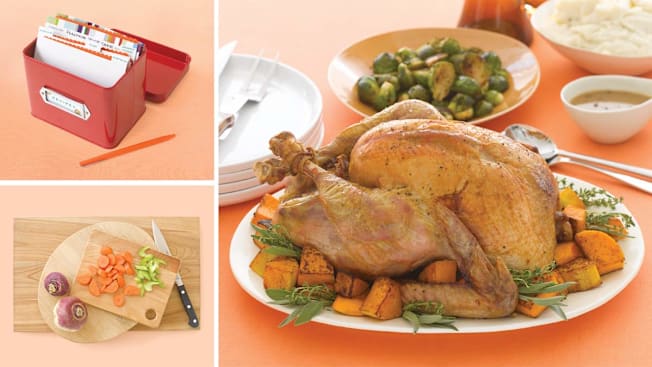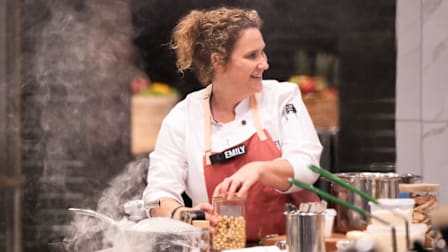Your Thanksgiving Prep Timeline
Follow this schedule to take the stress out of hosting the holiday meal
When you shop through retailer links on our site, we may earn affiliate commissions. 100% of the fees we collect are used to support our nonprofit mission. Learn more.

It’s just one meal, but shopping, prepping, and cooking for Thanksgiving dinner can feel overwhelming. The best way to save time and prevent cooking burnout is to break the tasks down and stick to an organized schedule. Here’s a handy holiday-meal countdown.
The Week Before
Do an equipment check. Serving dishes and utensils, meat thermometer, roasting pan—check now to make sure you have the gear you’ll need, so you still have time to buy or borrow what might be missing. It’s also a good idea to give small appliances you may not use all that often, like say a food processor or standing mixer, a test run, and to check your knives and get them sharpened if necessary. And don’t forget to see if you have enough food storage containers to handle the leftovers.
Three to Four Days Before
Label plates, platters, and bowls. Pull out serving pieces for all the dishes you plan to make so you aren’t rummaging through cabinets at the last minute. Use masking tape or sticky notes to designate which foods go where, allowing you to easily pass off plating to someone else on party day.
Shop for perishables. These include dairy products, salad greens, berries, and other items.
Buy or defrost the turkey. Now’s the time to pick up a fresh bird. If you’ve got a frozen one, give it enough time to defrost (and do it in the fridge for safety’s sake). The bigger the turkey, the longer it will take. Allow 24 hours for every four to five pounds, according to the Department of Agriculture. The agency’s Thawing Calculator will quickly help you figure out your timing.
The Day Before Thanksgiving
Boil the potatoes. Dice the potatoes to speed up cooking time. When they’re cooked, keep them covered in cold water to prevent discoloration and refrigerate. The next day, reheat and mash them just before serving.
Chop hard veggies like carrots, celery, and turnips. Refrigerate them in airtight plastic bags. If the same ingredients will be used in a few dishes, save time by chopping them all at once and measuring out what you need for each recipe. Prepare aromatic onions and garlic just before cooking because their flavors will dissipate quickly.
Assemble the stuffing. Prepare the wet and dry ingredients separately and combine them before baking to keep the stuffing from getting mushy.
Bake pies and tarts. To prevent sogginess, let them cool completely before wrapping them in foil. Pumpkin, sweet potato, and other pies with fillings that contain eggs or dairy should be stored in the refrigerator. However, others, such as apple and pecan pies, can be stored on the counter overnight.
Start defrosting sides and desserts. Transfer any frozen, premade items, such as soups or holiday cookies, to the refrigerator to defrost overnight.
On Thanksgiving
Finish preparing any food that has been partially cooked. Bake the stuffing, roast the meat, and reheat potatoes for mashing. Add fresh herbs to soups and vinaigrettes just before serving.
Bake fresh. For prime freshness, bake (or reheat if you’ve frozen them ahead of time) biscuits, rolls, and par-baked bread today; their textures can change even overnight.
Roast veggies. Roasted vegetables like brussels sprouts, potatoes, and parsnips lose crispness once they’re refrigerated. Cook them today. Serve them hot or at room temperature.
Whip cream. To keep it fluffy, save the whipping for the last minute. For a head start, pour the cream into a mixing bowl and refrigerate (with the beaters) until dessert time. You’ll get more volume and better texture if the cream, bowl, and beaters are cold when you start whipping.
Teach old appliances new tricks. Save oven space and burners for cooking, not reheating. Slow cookers can serve as chafing dishes, keeping meat, soups, and stews warm for hours. They can also be used for longer-cooking recipes, such as scalloped potatoes, meatballs, or even a hot dip. Toaster ovens can keep sides warm until serving and even bake a small casserole or dinner rolls, freeing oven space for larger dishes. And don’t forget the grill; it can be used as an extra warming surface. In fact, CR’s experts have cooked an entire Thanksgiving feast on a grill.
Great Kitchen Gear from CR's Tests
Hard-working tools like these can be a big help during the holiday season. Here are some top-rated picks from CR’s tests.




















